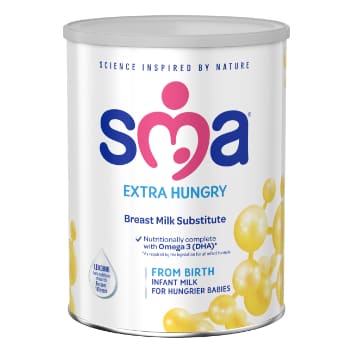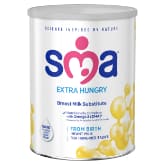SCIENCE INSPIRED BY NATURE
SMA® Extra Hungry Infant Milk
A nutritionally complete, casein dominant infant milk for hungrier babies. Designed to help delay weaning until the recommended time.
Product description

A casein-dominant infant milk formula that may help delay weaning in hungrier infants until the recommended time of 6 months.
Nutritionally complete and can be used from birth.
Contains 80% casein and 20% whey protein.
The UK Department of Health and the Health Service Executive in Ireland recommend exclusive breastfeeding for 6 months.1,2 If complementary foods are introduced before 4 months, studies have shown detrimental effects on the baby.3
SMA® Extra Hungry Infant Milk may help delay weaning until the recommended time.
Halal Certified.
Data card
Formats

800 g powder
The scoop is provided under the foil seal. Use product within 4 weeks of opening.
Preparation
Information for you to give to parents
How to open and prepare your baby's feed
While this product is made under strict hygienic conditions, it is not sterile. Failure to follow instructions on preparation and storage may make your baby ill.

Pull the safety seal and open the lid. Lift the tab, pull on the foil seal, carefully and safely remove the seal and dispose of it. The scoop is provided under the foil seal.

Wash hands well. Wash and sterilise all utensils according to manufacturers’ instructions.

Boil 1 litre of fresh tap water. Allow boiled water to cool for no more than 30 minutes. Measure the required amount of water (see feeding guide) into a sterilised bottle, carefully – the water is hot. Do not use artificially softened or repeatedly boiled water.

Using only the scoop provided, add the correct number of scoops of powder (see feeding guide), levelling off each scoop with the back of a clean, dry knife. Replace lid.

Place the sterilised teat and cap on the bottle and shake well until powder is fully dissolved. Cool bottle under cold running water or in a bowl or jug of cold water until lukewarm, do not immerse the teat. Test temperature by shaking a few drops onto the inside of your wrist.
Feeding guide
Information for you to give to parents
Feeding guide – powdered milk
|
Feeding guide birth – 12 months |
||||||
|
Approx. age of baby |
Approx. weight of baby |
Preparation for single feeds |
Feeds in 24 hours |
|||
|
Cooled, freshly boiled water |
||||||
|
kg |
lb |
Level scoops |
ml |
fl. oz. (approx.) |
||
|
Birth – 2 weeks |
3.4 |
7½ |
3 |
90 |
3 |
6 |
|
2 – 4 weeks |
3.7 |
8 |
4 |
120 |
4 |
6 |
|
4 – 8 weeks |
4.2 |
9¼ |
4 |
120 |
4 |
6 |
|
2 months |
5.3 |
11¾ |
5 |
150 |
5 |
5 |
|
3 months |
6.1 |
13½ |
6 |
180 |
6 |
5 |
|
4 months |
6.7 |
14¾ |
6 |
180 |
6 |
5 |
|
6 months |
7.6 |
16¾ |
8 |
240 |
8 |
4 |
|
7 – 12 months |
- |
- |
7 |
210 |
7 |
3 |
This table is a guide only; a baby may need more or less than the volumes stated. Caregivers should consult their healthcare professional if more advice is needed. Remember, a baby should be fed on demand. Mix 1 scoop of powder to 30 ml (approx. 1 fl. oz.) of water. Approx. 186 scoops per can. 1 scoop = 4.3 g
Important feeding information
Information for you to give to parents
SMA® Extra Hungry Infant Milk powder – 800 g
|
|
Do not add extra powder or water to make the feeds stronger or weaker and do not press powder into scoop. Using too much or too little powder can make your baby ill. |
|
|
We recommend preparing each feed in individual bottles when required. |
|
|
For hygienic reasons, discard unfinished feed in the bottle as soon as possible. |
|
|
For older babies, made-up formulae can be added to food. |
|
|
Do not alter or add to formulae unless medically directed. |
|
|
Do not warm feeds in a microwave, hot spots may occur and cause scalding. |
|
|
Remember, cows' milk should not be used as a drink during the first year. |
-
Department of Health. Infant feeding recommendation. May 2003 Available at: http://webarchive.nationalarchives.gov.uk
-
Best Practice for Infant Feeding in Ireland. Food Safety Authority of Ireland, 2012.
-
Department of Health. COMA working Group on the weaning diet. Weaning and the weaning diet. London (1994).
-
Billeaud C et al. Eur J Clin Nutr 1990; 44: 577–583.
-
Koletzko B et al.The roles of long-chain polyunsaturated fatty acids in pregnancy, lactation and infancy: review of current knowledge and consensus recommendations. J Perinat Med 2008; 36: 5–14.
IMPORTANT NOTICE:
The World Health Organisation (WHO) has recommended that pregnant women and new mothers be informed on the benefits and superiority of breastfeeding – in particular the fact that it provides the best nutrition and protection from illness for babies. Mothers should be given guidance on the preparation for, and maintenance of, lactation, with special emphasis on the importance of a well-balanced diet both during pregnancy and after delivery. Unnecessary introduction of partial bottle-feeding or other foods and drinks should be discouraged since it will have a negative effect on breastfeeding. Similarly, mothers should be warned of the difficulty of reversing a decision not to breastfeed. Before advising a mother to use an infant formula, she should be advised of the social and financial implications of her decision: for example, if a baby is exclusively bottle-fed, more than one can (400 g) per week will be needed, so the family circumstances and costs should be kept in mind. Mothers should be reminded that breast milk is not only the best, but also the most economical food for babies. If a decision to use an infant formula is taken, it is important to give instructions on correct preparation methods, emphasising that unboiled water, unsterilised bottles or incorrect dilution can all lead to illness.


